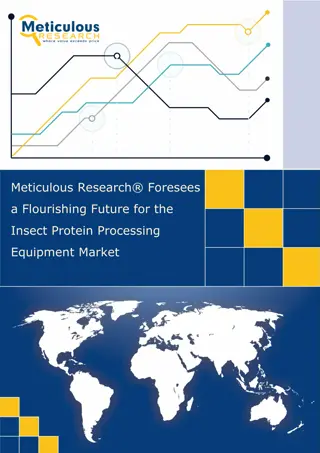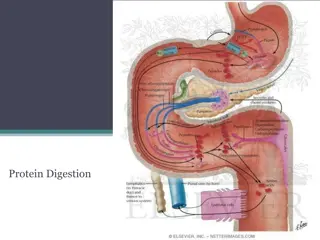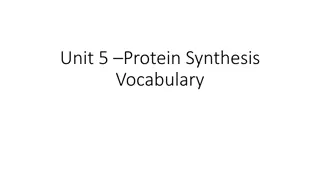Protein Synthesis Process Explained with Mrs. Griffiths
The protein synthesis process involves transcription where mRNA is made from DNA, followed by translation where tRNA molecules bring amino acids to assemble a polypeptide chain. This detailed explanation by Mrs. Griffiths covers the steps of DNA unwinding, mRNA formation, tRNA activation, ribosome attachment, and the synthesis of a polypeptide chain until a stop codon is reached. It also includes images illustrating each step vividly, enhancing the understanding of this fundamental biological process.
Uploaded on Dec 09, 2024 | 0 Views
Download Presentation

Please find below an Image/Link to download the presentation.
The content on the website is provided AS IS for your information and personal use only. It may not be sold, licensed, or shared on other websites without obtaining consent from the author. Download presentation by click this link. If you encounter any issues during the download, it is possible that the publisher has removed the file from their server.
E N D
Presentation Transcript
AS Biology Protein Synthesis Mrs Griffiths
Protein synthesis pg 72-73 1. DNA unwinds 2. mRNA copy is made of one of the DNA strands. 3. mRNA copy moves out of nucleus into cytoplasm. 4. tRNA molecules are activated as their complementary amino acids are attached to them. 5. mRNA copy attaches to the small subunit of the ribosomes in cytoplasm. 6 of the bases in the mRNA are exposed in the ribosome. 6. A tRNA bonds complementarily with the mRNA via its anticodon. 7. A second tRNA bonds with the next three bases of the mRNA, the amino acid joins onto the amino acid of the first tRNA via a peptide bond. 8. The ribosome moves along. The first tRNA leaves the ribosome. 9. A third tRNA brings a third amino acid 10. Eventually a stop codon is reached on the mRNA. The newly synthesised polypeptide leaves the ribosome.
Transcription 1 (making a mRNA copy of DNA) The part of the DNA molecule (the gene) that the cell wants the information from to make a protein unwinds to expose the bases. Free mRNA nucleotides in the nucleus base pair with one strand of the unwound DNA molecule.
Transcription 2 The mRNA copy is made with the help of RNA polymerase. This enzyme joins up the mRNA nucleotides to make a mRNA strand. This mRNA strand is a complementary copy of the DNA (gene) The mRNA molecule leaves the nucleus via a nuclear pore into the cytoplasm
tRNA pick up their specific amino acids from the cytoplasm
mRNA attaches to small ribosomal subunit
Translation. mRNA used to make polypeptide chain (protein)
1. First the mRNA attaches itself to a ribosome (to the small subunit). Six bases of the mRNA are exposed. A complementary tRNA molecule with its attached amino acid (methionine) base pairs via its anticodon UAC with the AUG on the mRNA in the first position P. Another tRNA base pairs with the other three mRNA bases in the ribosome at position A. The enzyme peptidyl transferase forms a peptide bond between the two amino acids. The first tRNA (without its amino acid) leaves the ribosome.
Translation 2 The ribosome moves along the mRNA to the next codon (three bases). The second tRNA molecule moves into position P. Another tRNA molecule pairs with the mRNA in position A bringing its amino acid. A growing polypeptide is formed in this way until a stop codon is reached.
End of Translation A stop codon on the mRNA is reached and this signals the ribosome to leave the mRNA. A newly synthesised protein is now complete!
Translation mRNA to Polypeptide
This powerpoint was kindly donated to www.worldofteaching.com http://www.worldofteaching.com is home to over a thousand powerpoints submitted by teachers. This is a completely free site and requires no registration. Please visit and I hope it will help in your teaching.























